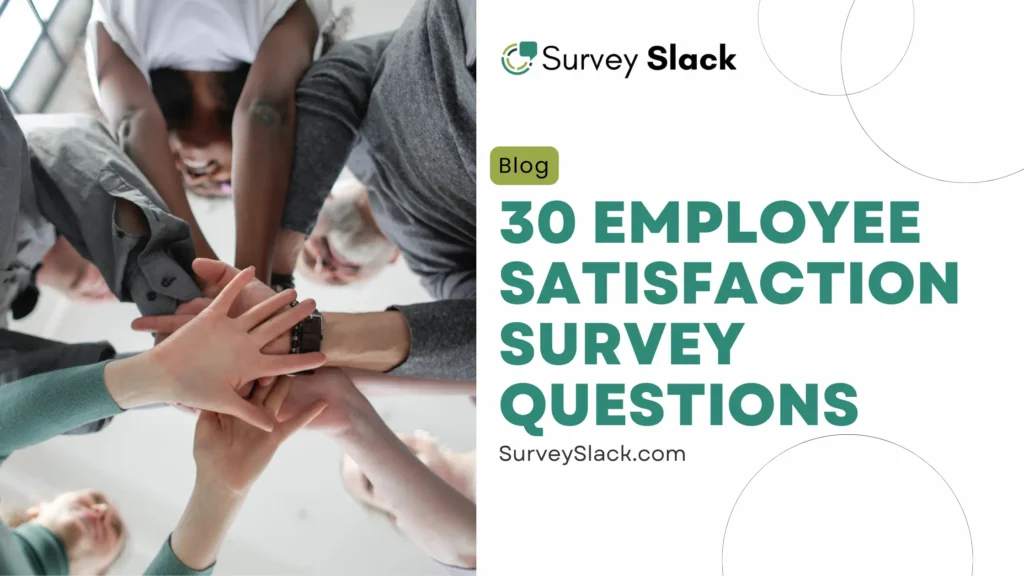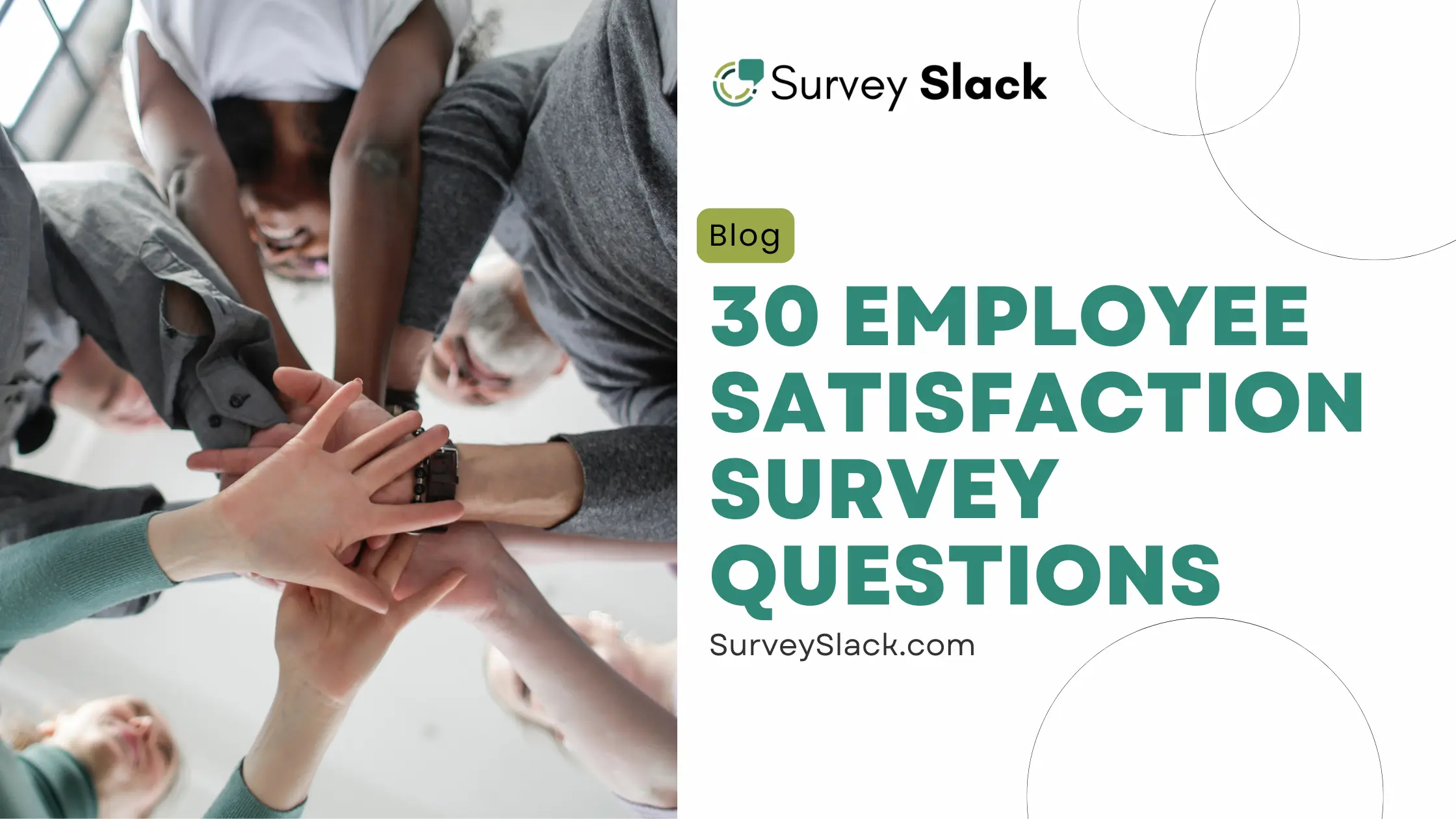Employee Satisfaction Survey Questions: Comprehensive Guide & Examples

Happy employees equals a happy business. That’s a no-brainer. But how do you know what your employees are thinking? Easy – ask them.
Employee satisfaction surveys are your secret lethal weapon. They’re like a crystal ball into your team’s minds. Want to know what makes them tick? What frustrates them?
This guide will show you how to craft killer employee satisfaction survey questions. Let’s dive in.
Why Employee Satisfaction Surveys Matter
Why bother with an employee satisfaction survey or employee engagement survey? It’s simple. Happy employees equal a productive workforce. Surveys give you a clear picture of what’s working and what’s not. You can spot problems before they blow up and turn those insights into action with the right online survey creator. Think of it as a roadmap to a better workplace.
These surveys play a vital role in:
- Identifying areas of strength and weakness in the workplace.
- Gauging employee morale and engagement.
- Uncovering potential issues before they escalate.
- Providing employees with a voice in the organization.
- Informing decision-making processes for HR and management.
Remember, a survey isn’t just about collecting data. It’s about turning insights into action.
Set clear goals before you start. What do you hope to achieve? Higher engagement? Lower turnover? Increased productivity? Knowing your ‘why’ will guide your questions and analysis.
Suggested Read:
- The Top Employee Satisfaction Survey Tools for 2024
- Create a Free Survey with No Hidden Charges Quick and Fresh
Types of Employee Satisfaction Surveys
There are several types of employee satisfaction surveys:
- Annual surveys: Comprehensive assessments are conducted once a year.
- Pulse surveys: Short, frequent surveys to gauge quick sentiment.
- Onboarding surveys: Gather feedback from new hires.
- Exit surveys: Understand why employees are leaving.
Crafting Effective Survey Questions
Writing good survey questions is an art. You want to get straight to the point without confusing people. Mix it up with different question types – like yes/no, multiple choice, and open-ended. This gives you a well-rounded picture.
Here are some tips:
- Keep questions clear and concise.
- Use a mix of question types (multiple choice, Likert scale, open-ended).
- Avoid leading questions.
- Cover all aspects of the employee experience.
Avoid tricky wording or leading questions. You want honest answers, not guesses. Keep it simple and let your employees speak their minds. Remember, the goal is to understand their experience, not impress them with fancy words.
Suggested Read:
- 10 Best Online Form Builder Tools for Perfect Results
- How Can You Build a Better Business Without Listening to Your Customers
Core Areas to Cover in Your Survey
What should you ask? Let’s break it down. You need to cover the basics: job satisfaction, work environment, leadership, pay, and benefits. But don’t stop there. Dive deeper. How’s work-life balance? Is communication clear? Are employees feeling valued and recognized?
Think about growth opportunities. Does your company offer chances to learn and advance? What about diversity and inclusion? Everyone deserves to feel respected and heard. These topics might seem sensitive, but they’re crucial for building a positive workplace.
Sample Employee Satisfaction Survey Questions
Creating a comprehensive list of questions can be overwhelming. Here are some examples to get you started. Remember, these are just suggestions. Tailor them to your specific company and goals.
Demographic Information:
- Department
- Job role
- Tenure
- Age
- Gender
Job Satisfaction:
- How satisfied are you with your overall job?
- Does your job align with your career goals?
- How challenging is your workload?
- Do you feel recognized for your work?
- How satisfied are you with your work-life balance?
- Do you feel your skills and abilities are fully utilized in your current role?
- How often do you feel stressed or overwhelmed by your job responsibilities?
Work Environment:
- How supportive is your team?
- Do you feel valued as an employee?
- How effective is communication within your team?
- How satisfied are you with the company culture?
- How accessible is senior management?
- Do you feel respected at work?
- Are you satisfied with the level of flexibility in your work arrangements (e.g., remote work options, flexible hours)?
Leadership:
- How effective is your immediate supervisor?
- Does your manager listen to your ideas?
- Is credit given where it’s due?
- Do you feel supported by your manager?
- Does your manager provide clear expectations?
- How well does your manager communicate?
Compensation and Benefits:
- Are you satisfied with your compensation?
- How clear is the pay structure?
- Is overtime compensated fairly?
- Are you satisfied with your benefits package?
- Do you feel your compensation is fair compared to others in your role?
Open-Ended Questions:
- Where do you see yourself in 5 years?
- How can we better support your career goals?
- What do you like most about working here?
- What do you like least about working here?
- What can the company do to improve your job satisfaction?
- What would make you more likely to stay with the company?
Remember to balance quantitative questions (Likert scale, multiple choice) with qualitative open-ended questions for deeper insights.
Download our comprehensive “Employee Satisfaction Survey Questions PDF” for a printable guide that includes 30 expertly crafted questions, covering all aspects of workplace satisfaction from job roles to company culture, ensuring you have the tools to gather meaningful insights and drive positive change in your organization.
Industry-Specific Employee Pulse Survey Questions
Technology Industry
- How satisfied are you with the company’s technology infrastructure?
- Do you feel you have adequate resources to perform your job effectively?
- How often do you feel challenged and stimulated by your work?
- How satisfied are you with the opportunities for professional development and learning new skills?
- How effective is the company at fostering innovation and creativity?
Healthcare Industry
- How satisfied are you with the patient care provided?
- How well does the company support work-life balance, considering the demanding nature of the healthcare industry?
- How satisfied are you with the level of support provided for your well-being and mental health?
- How effective is the communication between different departments within the healthcare facility?
- How satisfied are you with the opportunities for career advancement within the healthcare organization?
Retail Industry
- How satisfied are you with the company’s customer service training?
- How well does the company support employee engagement with customers?
- How satisfied are you with the company’s sales goals and performance metrics?
- How effective is the company’s inventory management system?
- How satisfied are you with the company’s scheduling flexibility?
Calculating Employee Net Promoter Score (eNPS)
Want a quick pulse check on employee loyalty? Calculate your eNPS. It’s simple. Ask one key question: “How likely are you to recommend working at this company to a friend or colleague?” Use a scale of 0 to 10.
People who score 9 or 10 are your promoters – they love your company. Those scoring 7 or 8 are passives – they’re okay but not raving fans. And scores 0 to 6? Those are detractors. To calculate eNPS, subtract the percentage of detractors from the percentage of promoters. That’s it!
A high eNPS means more happy, loyal employees. It’s a powerful metric to track over time and see the impact of your employee initiatives.
Using Survey Data to Drive Employee Retention
Your survey data is a goldmine for keeping top talent. By analyzing responses, you can pinpoint what’s driving people away. Is it a lack of growth, poor work-life balance, or something else? Once you know the problem, you can fix it.
Create targeted retention strategies based on your findings. Offer more training, flexible work options, or better compensation. Remember, it’s not just about fixing problems. Celebrate wins too. Recognize and reward employees. Show them they’re valued. Track your progress over time to see what works and what doesn’t.
The goal? A happier, more loyal workforce.
Case Studies of Successful Employee Satisfaction Surveys
Want proof that surveys work? Look no further. Companies across industries are transforming their workplaces with insights from employee feedback.
Take Buffer, for example. This social media management tool company is famous for its open culture. Their annual State of Remote work survey has been instrumental in shaping their remote-first policies. By listening to employees, they’ve created a workplace that attracts top talent and boosts productivity.
Another great example is Adobe. They’ve used employee feedback to overhaul their performance management system. By focusing on continuous feedback and development, they’ve created a more engaged and motivated workforce.
Want to learn more? Check out these resources:
Remember, these are just a few examples. There are countless success stories out there. Find what inspires you and start building your own.
Best Practices for Survey Administration and Analysis
Okay, you’ve crafted the perfect survey. Now, how do you get people to take it? First, choose the right platform. Online surveys are usually the easiest but consider your audience. Some people prefer paper or even face-to-face interviews.
Keep it confidential. People are more likely to be honest if they know their answers are private. Promote the survey widely. Send reminders, and offer incentives if possible. And remember, timing is everything. Don’t overwhelm people with surveys.
Once you have the data, it’s time to dig in. Use employee satisfaction survey tools and software to analyze your results. Look for patterns, trends, and outliers. Turn data into actionable insights. Don’t just share numbers. Tell a story with your findings. Use visuals like charts and graphs to make it easy to understand.
Remember, a survey is just the beginning. It’s the follow-up that counts. Share the results with your team. Be transparent about what you’re doing to address their concerns. And most importantly, follow through on your promises.
Consistent surveys over time will help you track progress and make a real impact on employee satisfaction.
Frequently Asked Questions (FAQs):
What are good employee satisfaction survey questions?
Good questions cover various aspects of the work experience, including:
– How often do you feel valued in your role?
– Which aspects of your job do you find most fulfilling?
– How would you rate the work-life balance in our organization?
– Do you feel our company provides value for your time and effort?
What does the Job Satisfaction Survey (JSS) measure?
The JSS measures several facets of job satisfaction, including:
– Pay.
– Promotion opportunities.
– Supervision.
– Fringe benefits.
– Contingent rewards.
– Operating conditions.
– Coworker relationships.
– Nature of work.
– Communication.
How do you conduct an employee satisfaction survey?
To conduct an employee satisfaction survey:
– Define your objectives.
– Choose appropriate questions.
– Select a survey platform.
– Ensure anonymity.
– Distribute the survey.
– Analyze results.
– Take action based on findings.
What are the five elements of employee satisfaction?
Far far away, behind the word mountains, far from the countries Vokalia and Consonantia, there live the blind texts. Separated they live in Bookmarksgrove right at the coast of the Semantics, a large language ocean.
Add your title here
The five key elements are:
– Livable wages.
– Mobility and growth opportunities within the company.
– Workplace flexibility and schedule control.
– Benefits.
– Working conditions and safety.
What is employee engagement?
Employee engagement refers to the emotional commitment and connection employees have to their work, company, and its goals.
How do you write good survey questions?
To write good survey questions:
– Keep them clear and concise.
– Avoid leading or biased language.
– Use a mix of question types.
– Focus on one concept per question.
– Ensure questions are relevant to your objectives.
How do you structure a satisfaction survey?
Structure a satisfaction survey by:
– Starting with an introduction.
– Grouping related questions together.
– Using a logical flow from general to specific.
– Including a mix of closed-ended and open-ended questions
– Ending with demographic questions (if necessary).
What are the different types of employee survey questions?
Different types include:
– Likert scale questions.
– Multiple-choice questions.
– Open-ended questions.
– Yes/No questions.
– Rating scale questions.
What should you do with your feedback data?
With feedback data:
– Analyze trends and patterns.
– Share results with leadership and employees.
– Develop action plans based on insights.
– Implement changes.
– Follow up to measure the impact of changes.
What is a good survey participation rate?
A good participation rate for employee surveys is typically considered to be 70% or higher, though this can vary depending on the organization and survey frequency.
Conclusion
Happy employees equal a thriving business. It’s that simple. Employee satisfaction surveys are your roadmap to a happier, more productive workforce. By asking the right questions, listening to your team, and taking action, you can create a workplace where people love to come to work. Create online polls and training survey to understand and improve their output.
Remember, this isn’t a one-time thing. Employee satisfaction is a journey, not a destination. Keep the feedback loop open. Regularly check in with your team to see how things are going. By making employee satisfaction a priority, you’ll reap the rewards for years to come.
So, what are you waiting for? Start building a happier, more engaged team today.





